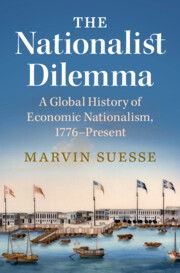Book contents
- The Nationalist Dilemma
- The Nationalist Dilemma
- Copyright page
- Dedication
- Contents
- 1 Introduction: Nationalists Think About the Economy
- 2 The American Community of the Common Man, 1776–1860
- 3 The Birth of the National Economy in Europe, 1789–1860
- 4 The Globalisation of the Nation, 1861–1913
- 5 The Nationalist as Saviour, 1914–1945
- 6 Policy in a World of Nation-States, 1946–1978
- 7 The Incomplete Building of a Global Economy, 1979–2001
- 8 Populist Discontents, 2002–2021
- 9 Conclusion and Outlook: Explaining Economic Nationalism
- Notes
- Index
7 - The Incomplete Building of a Global Economy, 1979–2001
Published online by Cambridge University Press: 25 April 2023
- The Nationalist Dilemma
- The Nationalist Dilemma
- Copyright page
- Dedication
- Contents
- 1 Introduction: Nationalists Think About the Economy
- 2 The American Community of the Common Man, 1776–1860
- 3 The Birth of the National Economy in Europe, 1789–1860
- 4 The Globalisation of the Nation, 1861–1913
- 5 The Nationalist as Saviour, 1914–1945
- 6 Policy in a World of Nation-States, 1946–1978
- 7 The Incomplete Building of a Global Economy, 1979–2001
- 8 Populist Discontents, 2002–2021
- 9 Conclusion and Outlook: Explaining Economic Nationalism
- Notes
- Index
Summary
The institutions of the developmental states set up in the postwar period began to crumble in the 1980s as liberalisation took hold. Isolationist approaches were on the back foot. However, this did not mark the end of economic nationalism. Nation-states were now recast as agents shaping competitiveness and therefore growth. This process is visible in the Baltic states breaking free from the Soviet Union, in Malaysia of the 1990s, and most importantly in reform-era China. Beyond these similarities, the differences are equally enlightening. China’s reforms as conceived by Deng Xiaoping saw an initially cautious, but increasingly rapid, dismantling of Maoist autarky, with the ‘rejuvenation’ of the nation becoming the principal aim. Malaysia under Mahathir Mohamad only slowly moved towards a developmental policy, because policy also tried to achieve the economic advancement of ethnic Malays over the country’s ethnic Chinese minority. Finally, not all independent states born from the Soviet dissolution could turn to the West. Ukraine in the early 1990s remained caught between internal divisions and increasingly aggressive Russian policy.
Keywords
- Type
- Chapter
- Information
- The Nationalist DilemmaA Global History of Economic Nationalism, 1776–Present, pp. 223 - 267Publisher: Cambridge University PressPrint publication year: 2023

